Dundee Medical School
A Celebration of the University of Dundee Medical School
An online version of the Tayside Medical History Museum exhibition orignally staged in the Medical School Foyer, Ninewells Hospital, Dundee, to mark the 40th anniversary of the independent University of Dundee
September 2007 - February 2008
Dundee's Medical School was conceived in the 1880s and established as a Faculty of the University of St Andrews. In 1967 the independent University of Dundee was formed, with the Medical School as one of its most significant parts.
This exhibition by the Tayside Medical History Museum looks at the history of the Medical School, focusing on its successes over the past 40 years.
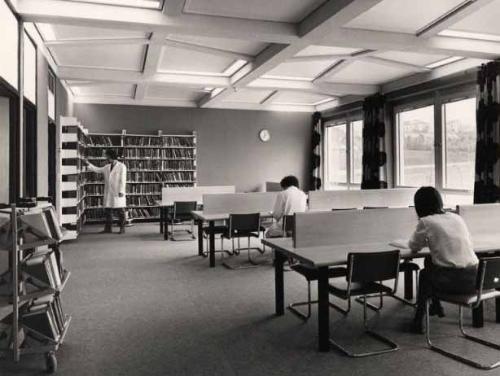
Medical School Library, Ninewells Hospital, 1974 (Courtesy of University of Dundee Archive Services)
An online version of the Tayside Medical History Museum exhibition
The Conjoint Medical School 1887-1967
By the time University College Dundee (UCD) was founded in 1881, the town already had impressive hospital facilities at the Royal Infirmary (DRI) and the Royal Lunatic Asylum. Medicine was therefore an obvious subject for the College to teach, but at that time it had no power to award degrees.
Across the Tay, the ancient University of St Andrews had been awarding medical degrees since 1696, but by 1881 it was struggling to keep going with fewer than 200 students attending. A merger seemed the obvious solution, and in 1887 UCD published its proposals for a Medical School.

Dundee Royal Infirmary Opened in 1855 to replace an earlier hospital from 1798, the DRI was where students received most of their clinical training until the opening of Ninewells in 1974.
In 1889 the government passed an Act allowing UCD to become affiliated with St Andrews for the purpose of "establishing a fully equipped Conjoint University School of Medicine". Unfortunately, the development of the Conjoint School was the subject of bitter disputes between Dundee and St Andrews. These became so destructive that in 1894 St Andrews tried to take legal action against the Act and thus sever ties with Dundee altogether. They lost the case, and in 1897 UCD officially became a college of St Andrews University, and a Faculty of Medicine was established to operate the Conjoint School.
While most of the clinical subjects were taught at DRI, pre-clinical training was at first carried out mainly at St Andrews. Dundee had established Chairs of Anatomy and Physiology in 1888-89 but had only limited facilities to teach the subjects until the construction of a proper Medical School building in 1902-04. Designed by local architect J Murray Robertson, it opened just in time for the first visit by the General Medical Council to assess the new degree. Although critical in some areas, the examiners declared the school "sufficient". Its reputation was to grow from there.
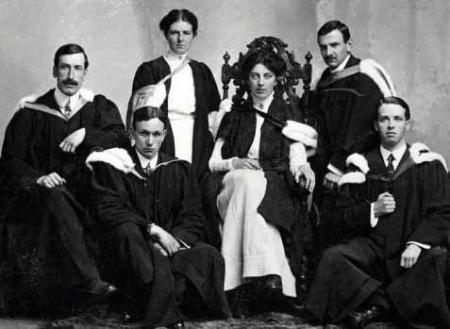
Medical Students, 1909 - Included in this group of students, second from left, is W J Tulloch. He would later return to Dundee as the first Professor of Bacteriology, and became Dean of Medicine in 1945.
(Courtesy of University of Dundee Archive Services)
Staff and student numbers grew steadily during the first half of the 20th century. In 1954 UCD was reformed as Queen's College, bringing the Medical School under the College's official administration for the first time.
The new National Health Service changed the way medical courses were run and led to a further expansion of teaching staff and facilities, Maryfield also becoming a teaching hospital. There was also a notable increase in research work being carried out at the school.
By the time the independent University of Dundee was created in 1967, the building of Ninewells was already underway, and work began on a new Medical Sciences Institute on the main campus later that year. The new independent Medical School thus began with great expectations!
Ninewells Hospital
During the Second World War, the Secretary of State for Scotland arranged a survey of hospitals throughout the country to determine what changes might be required in order to develop a comprehensive and co-ordinated post-war hospital service. In the Eastern Region, attention was focused on the inadequacy of teaching facilities at Dundee Royal Infirmary and Maryfield Hospital.
The Surveying Officers recommended that long-term policy should contemplate conjunction of the two hospitals and the building of a large new general hospital that would form the nucleus of both hospital and medical educational centre.
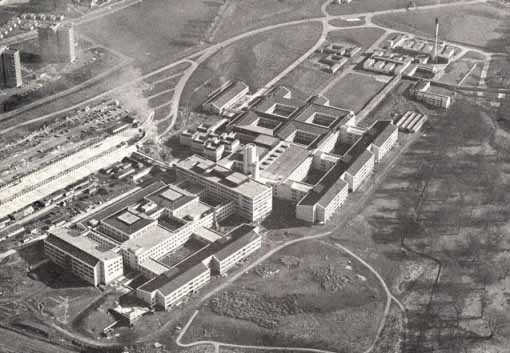
Aerial view of Ninewells Hospital, 1972
The 1946 Pearson Report commissioned by the University of St Andrews disagreed with the Scottish Hospitals Survey and suggested that a new medical school might be constructed next to DRI in Dudhope Park. However, on the advice of the Department of Health for Scotland, the University Court deferred a decision until the Regional Hospital Board was constituted in 1948. The new Board soon decided that the interests of the University and the region as a whole would be best served by the erection of a new hospital centre on the outskirts of Dundee which would also provide space for the development of a new medical school; the University agreed.
The Ninewells site was obtained after lengthy negotiations in 1955. Subsequent rapid progress through the initial design stages was followed by delays and difficulties during construction. A full quarter of a century after the Secretary for State gave approval in principle, Ninewells eventually opened for business in 1974.
Policy decisions, taken jointly by the Regional Hospital Board and the University, established three key elements in the brief:
- Embedding - the closest possible 'through the door' relationship between research, teaching and patient care functions
- Integration - a high degree of common facilities and supply systems serving both Hospital and Medical school
- Standardisation - in the physical elements of the building for reasons of flexibility in use

A key feature of Ninewells is the 'embedding' of the Medical School in the hospital.
The key elements of both hospital and school are situated around the central concourse and supply core.
The Medical School and clinics are grouped on either side, with the wards situated on the quieter southerly aspect. Each was designed with expansion in mind.
The diagram shown here is from the preliminary sketch plans of 1961.
Image courtesy of NHS Tayside

Ninewells was the first completely new UK teaching hospital to be built in the 20th century, and most aspects of policy and design had to be considered from scratch. An experimental approach was therefore required, and a £50,000 programme of full scale mock-ups allowed testing of certain key areas of layout, equipment and component design in the wards, laboratories and operating theatres. Here Professor Sir Donald Douglas tries out a mock-up operating theatre.
Image courtesy of NHS Tayside
The Medical School at Ninewells was initially designed for an intake of 65 students per year, but by the time of opening this figure had increased to 110. The current intake has now reached over 150 students each year.
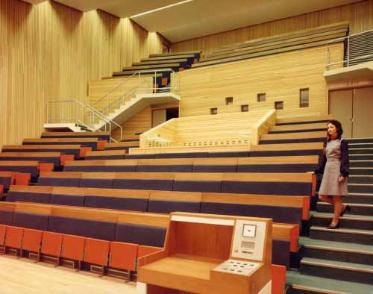
Lecture theatre, 1974 (Courtesy of NHS Tayside)
The Dundee Curriculum
In an address on university education in 1876, Thomas Huxley stated: "The burden we place on the medical student is far too heavy, and it takes some doing to keep from breaking his intellectual back. A system of medical education that is actually calculated to obstruct the acquisition of sound knowledge and to heavily favour the crammer and grinder is a disgrace".
Despite Huxley's concerns, for most of the next century the medical curriculum was based on the mastery of an increasing number of subjects with the basic medical sciences featuring prominently. The student was examined in each subject as he completed his 'course' in it.
Concern about the over-dominance of basic sciences saw a move in the 1960s and 70s to a more integrated approach to the curriculum. In 1972, Dundee introduced a "co-ordinated systematic course in medical studies", which linked the disciplines of medicine, surgery, obstetrics, paediatrics and therapeutics closely with pathology and microbiology. Attempts to integrate a clinical teaching programme was less successful at that time.
Huxley's "overloading of the curriculum" had been noted by the General Medical Council as far back as 1863 and was to be reiterated time and again. It was not until 1993 that the GMC through its document Tomorrow's Doctors was at last able to confront this problem that "taxed the memory but not the intellect".
Dundee's response to Tomorrow's Doctors was led by Professor Ronald Harden, and produced a spiral curriculum in which learning in the first three years was centered around body systems (normal structure and function in year 1 followed by systematic study of the abnormal in years 2 and 3). During clinical attachments in years 4 and 5 students would learn how to use this knowledge to master tasks related to around 100 "core clinical problems or scenarios".

The Spiral Curriculum(Courtesy of the Centre for Medical Education)

Responses to the statement "Medical school prepared me well for the jobs I have undertaken so far" from graduates of 23 medical schools. On the chart, Dundee is school number 1.
A strong endorsement of the Dundee Curriculum in equipping junior doctors for the first stage of their working lives came from this national questionnaire survey of 1999/2000 graduates. A further survey in 2007 gives the same result - Dundee is No 1!
Courtesy of the British Medical Journal
Student Experiences

Dundee Adventure Group (DAG) was a voluntary student body which organised activities for children from some of the most deprived families in Dundee. Activities included walks in Tentsmuir forest, weekend camp at Glen Clova and games at the Menzieshill sports centre.
This photograph shows the original members of the group on Dundee Law in 1971 - included are the current Chair of SIGN guidelines, Dean of the Faculty of Medicine at St Andrews University and President of the British Society for the History of Medicine - a distinguished bunch!
Private Collection
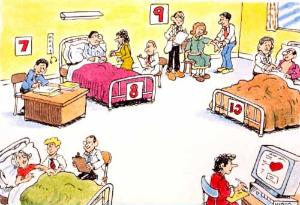
The Objective Structured Clinical Examination (OSCE) was developed in Dundee in the mid-1970s as a reliable objective method of measuring clinical skills, removing the 'luck of the draw' that had for so long been a bone of contention. Students are presented with a number of situations (exactly the same for each student) and have a fixed amount of time to deal with each one.
The system has been compared to a game of "musical beds", but has gone on to achieve worldwide acceptance.
Courtesy of the Centre for Medical Education

Students Common Room
The Students Common Room at
Ninewells in 1974(now the Curriculum Office,
above the Ian Low Centre)
(Courtesy of University of Dundee Medical School)

Audio-Visual Learning Materials
1973 saw the introduction of audio-visual learning materials to help encourage students towards independent learning, in response to poor ratings for biochemistry teaching. It may look primitive now, but feedback at the time was hugely positive.
(Courtesy of the Centre for Medical Education)